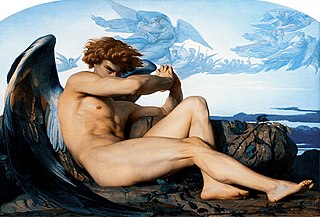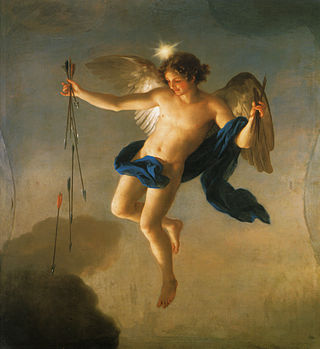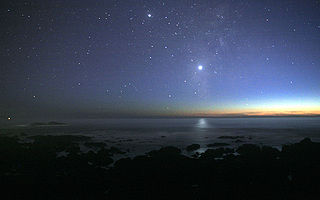
The most common meaning for Lucifer in English is as a name for the Devil in Christian theology. It appeared in the King James Version of the Bible in Isaiah and before that in the Vulgate, not as the name of a devil but as the Latin word lucifer (uncapitalized), meaning "the morning star", "the planet Venus", or, as an adjective, "light-bringing". It is a translation of the Hebrew word הֵילֵל, hêlēl, meaning "Shining One".

Satan, also known as the Devil, and sometimes also called Lucifer in Christianity, is an entity in Abrahamic religions that seduces humans into sin or falsehood. In Judaism, Satan is seen as an agent subservient to God, typically regarded as a metaphor for the yetzer hara, or "evil inclination". In Christianity and Islam, he is usually seen as a fallen angel or jinn who has rebelled against God, who nevertheless allows him temporary power over the fallen world and a host of demons. In the Quran, Shaitan, also known as Iblis, is an entity made of fire who was cast out of Heaven because he refused to bow before the newly created Adam and incites humans to sin by infecting their minds with waswās.

Satanism refers to a group of religious, ideological and/or philosophical beliefs based on Satan – particularly the worship or veneration of him. Satan is a figure of the devil in Christian belief, a fallen angel and leader of the devils who tempts humans into sin. For many centuries the term was used by various Christian groups as an accusation against ideological opponents. Actually self-identified Satanism is recent, and is thought to have begun with the founding of the Church of Satan by Anton LaVey in the United States in 1966 – that "church" being an atheistic group that does not believe in a literal Satan. Sharing "historical connections and family resemblances" with Satanism, and sometimes overlapping with it, are paganism, ceremonial magic, and "other dark entities such as Set, Lilith, Hecate, and Chaos", from the occult and the 'Left Hand Path milieu.'

The Taxil hoax was an 1890s hoax of exposure by Léo Taxil, intended to mock not only Freemasonry but also the Catholic Church's opposition to it.

The Church of Satan (CoS) is a religious organization dedicated to the religion of Satanism as defined by Anton Szandor LaVey. Founded in San Francisco in 1966, by LaVey, it is considered the "oldest satanic religion in continual existence", and more importantly the most influential, inspiring "numerous imitator and breakaway groups". According to the Church, Satanism has been "codified" as "a religion and philosophy" by LaVey and his church.

Anton Szandor LaVey was an American author, musician, and Satanist. He was the founder of the Church of Satan and the religion of Satanism. He authored several books, including The Satanic Bible, The Satanic Rituals, The Satanic Witch, The Devil's Notebook, and Satan Speaks! In addition, he released three albums, including The Satanic Mass, Satan Takes a Holiday, and Strange Music. He played a minor on-screen role and served as technical advisor for the 1975 film The Devil's Rain and served as host and narrator for Nick Bougas' 1989 mondo film Death Scenes.

A Black Mass is a ceremony celebrated by various Satanic groups. It has allegedly existed for centuries in different forms, and the modern form is intentionally a sacrilegious and blasphemous parody of a Catholic Mass.

The Satanic Bible is a collection of essays, observations, and rituals published by Anton LaVey in 1969. It is the central religious text of LaVeyan Satanism, and is considered the foundation of its philosophy and dogma. It has been described as the most important document to influence contemporary Satanism. Though The Satanic Bible is not considered to be sacred scripture in the way that the Christian Bible is to Christianity, LaVeyan Satanists regard it as an authoritative text as it is a contemporary text that has attained for them scriptural status. It extols the virtues of exploring one's own nature and instincts. Believers have been described as "atheistic Satanists" because they believe that God and Satan are not external entities, but rather projections of an individual's own personality—benevolent and stabilizing forces in their life. There have been thirty printings of The Satanic Bible, selling over a million copies.

Marie Joseph Gabriel Antoine Jogand-Pagès, better known by the pen name Léo Taxil, was a French writer and journalist who became known for his strong anti-Catholic and anti-clerical views. He is also known for the Taxil hoax, a spurious exposé of Freemasonry and the Roman Catholic Church's opposition to it.
LaVeyan Satanism is the name given to the form of Satanism promoted by American occultist and author Anton LaVey (1930-1997). LaVey founded the Church of Satan (CoS) in 1966 in San Francisco. Although LaVey is thought to have had more impact with his Satanic aesthetics of "colourful" rituals and "scandalous" clothes that created a "gigantic media circus", he also promoted his ideas in writings, such as the popular Satanic Bible. LaVeyan Satanism has been classified as a new religious movement and a form of Western esotericism by scholars of religion. LaVey's ideas have been said to weave together an array of sometimes "contradictory" "thinkers and tropes", combining "humanism, hedonism, aspects of pop psychology and the human potential movement", along with "a lot of showmanship", His ideas were heavily influenced by the ideas and writings of Friedrich Nietzsche, Ayn Rand and Arthur Desmond.

In Greek mythology, Hesperus is the Evening Star, the planet Venus in the evening. A son of the dawn goddess Eos, he is the half-brother of her other son, Phosphorus. Hesperus' Roman equivalent is Vesper. By one account, Hesperus' father was Cephalus, a mortal, while Phosphorus was the star god Astraios. Other sources, however, state that Hesperus was the brother of Atlas, and thus the son of Iapetus.

Theistic Satanism, otherwise referred to as religious Satanism, spiritual Satanism, or traditional Satanism, is an umbrella term for religious groups that consider Satan, the Devil, to objectively exist as a deity, supernatural entity, or spiritual being worthy of worship or reverence, whom individuals may contact and convene with, in contrast to the atheistic archetype, metaphor, or symbol found in LaVeyan Satanism. Organizations who uphold theistic Satanist beliefs most often have few adherents, are loosely affiliated or constitute themselves as independent groups and cabals, which have largely self-marginalized. Another prominent characteristic of theistic Satanism is the use of various types of magic. Most theistic Satanist groups exist in relatively new models and ideologies, many of which are independent of the Abrahamic religions.
The Infernal Names is a compiled list of adversarial or antihero figures from mythology intended for use in Satanic ritual. The following names are as listed in The Satanic Bible (1969), written by Church of Satan founder Anton Szandor LaVey. When calling the names, all of them may be recited, or a given number of those most significant to the respective working may be chosen. Not all were demons in their source culture; this list represents LaVey's interpretation of them and is presented below as they were written in the SatanicBible, and therefore is prone to historical errors and personal misconceptions.
Greater and lesser magic, within LaVeyan Satanism, designate types of beliefs with the term greater magic applying to ritual practice meant as psychodramatic catharsis to focus one's emotions for a specific purpose and lesser magic applied to the practice of manipulation by means of applied psychology and glamour to bend an individual or situation to one's will.
The Satanic panic is a moral panic about alleged widespread Satanic ritual abuse which originated around the 1980s in the United States, peaking in the early 1990s, before waning as a result of scepticism of academics and law enforcement agencies who ultimately debunked the claims. The phenomenon spread from the United States to other countries, including South Africa, where it is still evident periodically. South Africa was particularly associated with the Satanic panic because of the creation of the Occult Related Crimes Unit in 1992, described as the "world's only 'ritual murder' task force". According to anthropologist Annika Teppo, this was linked with powerful conservative Christian forces within the then-dominant white community in the last years of apartheid. Christian belief is a prerequisite to serve in the unit. The concern with the alleged presence of Satanism and occult practices has continued into the post-apartheid era.
Within the Church of Satan, a Grotto is a clandestine association or gathering of Satanists within geographical proximity for means of social, ritual, and special interest activities. The Black House, the founding place and headquarters of the Church of Satan from 1966 to 1997, was effectively the first grotto, and was for a time referred to as the "Central Grotto". Grottos existed for a time in various parts of the United States; these included the Babylon Grotto in Detroit, the Stygian Grotto in Dayton, and the Lilith Grotto in New York. In 1975, LaVey disbanded all grottos, then reinstated them in the 1980s. The Church of Satan no longer formally recognizes or charters grottos.
The various authors of the Hebrew Bible have provided various names.

Isaiah 14 is the fourteenth chapter of the Book of Isaiah in the Hebrew Bible or the Old Testament of the Christian Bible. This book contains the prophecies attributed to the prophet Isaiah, and is one of the Books of the Prophets.

Venus, as one of the brightest objects in the sky, has been known since prehistoric times and has been a major fixture in human culture for as long as records have existed. As such, it has a prominent position in human culture, religion, and myth. It has been made sacred to gods of many cultures, and has been a prime inspiration for writers and poets as the morning star and evening star.
Michael Wayne Raptor is an American occultist, author, and musician. He is the former co-president of the now closed Greater Church of Lucifer (GCOL) which was the first Luciferian building in the United States. It was located in Old Town Springs, Texas. More recently, he works with Jeremy Crow and Hope Marie Ford operating the Assembly of Light Bearers. Ford has published a number of books on the occult and recorded a number of albums as well. Ford's company, Succubus Productions Publishing publishes a majority of his English Language books, while his works have been translated into a number of languages and published by companies in Italy, Peru, Brazil, France, Germany, and Serbia. His magical name is Akhtya.













